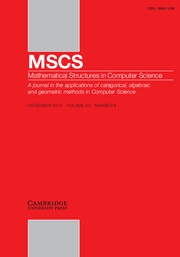No CrossRef data available.
Article contents
Prior’s ideal language
Published online by Cambridge University Press: 08 April 2025
Abstract
We present an axiom system for what we call Prior’s Ideal Language and prove its completeness and pure completeness with respect to general models. With this is done, we explain, with examples, why this system provides a useful setting for exploring Arthur Prior’s work.
Keywords
- Type
- Special Issue: WoLLIC 2023
- Information
- Copyright
- © The Author(s), 2025. Published by Cambridge University Press
References
Areces, C., Blackburn, P., Huertas, A. and Manzano, M. (2014). Completeness in hybrid type theory. Journal of Philosophical Logic 43 (2) 209–238.Google Scholar
Areces, C., Blackburn, P. and Marx, M. (2001). Hybrid logics: characterization, interpolation and complexity. The Journal of Symbolic Logic 66 (3) 977–1010.CrossRefGoogle Scholar
Areces, C. E. (2000). Logic Engineering: The Case of Description and Hybrid Logics. Phd thesis, Institute for Logic, Language and Computation.Google Scholar
Areces, C. and ten Cate, B. (2007). Hybrid logic. In: Handbook of Modal Logic, Elsevier, 821–868.Google Scholar
Baader, F., Calvanese, D., McGuinness, D., Patel-Schneider, P., Nardi, D. and Schneider, P. F. (2003). the Description Logic Handbook: Theory, Implementation and Applications, Cambridge University Press.Google Scholar
Belardinelli, F., Van Der Hoek, W. and Kuijer, L. B. (2018). Second-order propositional modal logic: expressiveness and completeness results. Artificial Intelligence 263 3–45.CrossRefGoogle Scholar
Blackburn, P., Braüner, T. and Kofod, J. (2023). An axiom system for basic hybrid logic with propositional quantifiers. In: Logic, Language, Information, and Computation – 29th International Workshop, WoLLIC. 2023, Proceedings, Lecture Notes in Computer Science, vol. 13923, Springer-Verlag, 118–134.Google Scholar
Blackburn, P., de Rijke, M. and Venema, Y. (2001). Modal Logic, Cambridge University Press.Google Scholar
Blackburn, P. and Seligman, J. (1995). Hybrid languages. Journal of Logic, Language and Information 4 (3) 251–272.Google Scholar
Blackburn, P. and ten Cate, B. (2006). Pure extensions, proof rules, and hybrid axiomatics. Studia Logica 84 (2) 277–322.CrossRefGoogle Scholar
Braüner, T. (2021). Hybrid logic. In: Zalta, E. (ed.) The Stanford Encyclopedia of Philosophy, Stanford University, On-line encyclopedia article available at http://plato.stanford.edu/entries/logic-hybrid.Google Scholar
Bull, R. (1969). On modal logic with propositional quantifiers. The Journal of Symbolic Logic 34 (2) 257–263.CrossRefGoogle Scholar
Copeland, B. J. (2017). Arthur prior. In: Zalta, E. N. (ed.) The Stanford Encyclopedia of Philosophy, Metaphysics Research Lab, Stanford University, summer 2017 edition.Google Scholar
Henkin, L. (1950). Completeness in the theory of types. The Journal of Symbolic Logic 15 (2) 81–91.Google Scholar
Kofod, J. L. (2022). What on Earth was Arthur Prior Thinking?: About Physics and Hybrid Logic. Phd thesis, IKH, Roskilde University.Google Scholar
Manzano, M., Huertas, A., Blackburn, P., Martins, M. and Aranda, V. (2023). Hybrid partial type theory. The Journal of Symbolic Logic 1–43. https://doi.org/10.1017/jsl.2023.33CrossRefGoogle Scholar
Øhrstrøm, P. and Hasle, P. (2007). Temporal Logic: From Ancient Ideas to Artificial Intelligence, vol. 57, Springer Science & Business Media.Google Scholar
Prior, A. (2003). Papers on Time and Tense, Oxford University Press, new expanded edition.Google Scholar
Prior, A. N. (1958). Epimenides the Cretan. The Journal of Symbolic Logic 23 (3) 261–266.Google Scholar
Prior, A. N. (1961). On a family of paradoxes. Notre Dame Journal of Formal Logic 2 (1) 16–32.Google Scholar
Ten Cate, B. (2005). Model Theory for Extended Modal Languages. Phd thesis, Institute for Logic, Language and Computation.Google Scholar
Thomason, S. (1972). Semantic analysis of tense logics. The Journal of Symbolic Logic 37 (1) 150–158.Google Scholar



